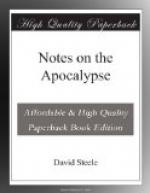or symbol, Babylon, was unwarrantably restricted in
import, as representing only the Church of Rome.
And it is to be deplored that most protestant expositors
continue to limit the inspired symbol in the same
way till the present time. The literal Babylon,
a name common to the ancient city and empire by the
river Euphrates, was in no sense a church; and it would
be anomalous and incongruous to select either city
or empire as an
emblem of a church! There
is, however, in the Apocalypse a combining or blending
of symbols in order clearly and fully to represent
a complex moral person. This has been already
exemplified in ch. xiii. 2, where the prominent features
of Daniel’s first
three beasts, (ch.
vii. 4-6,) are combined in John’s
first
beast of the sea. Just so in this instance.
The idolatrous and tyrannical Roman empire, in alliance
with an apostate church, constitutes mystical Babylon.
History demonstrates the fact of their coalition.
The great red dragon, the devil, operates through both
during the allotted period of 1260 years against the
witnesses of Christ. Sometimes, indeed, the nominal
church is the more active and visible instrument,
and at other times the state, in opposing Mediatory
authority; and thus Babylon, or one of her streets,
which is the equivalent of a horn of the beast, becomes
prominent. This second angel confidently proclaims,—“Babylon
is fallen, is fallen.” So said Isaiah of
literal Babylon long before the event; (ch. xxi. 9,)
and so said Jeremiah, (ch. li. 8,) to whose predictions
John obviously alludes. All these three prophets
speak in present time of a future event, simply because
of the settled and unalterable purpose of God, acting
not formally as a sovereign, but as a judge.
The multiplied and aggravated crimes of Babylon, literal
or mystical Babylon, are the just grounds of her deserved
and awful doom. From ancient times God has declared
by his prophets the things that are not yet done.
(Isa. xlvi. 10.) His counsel stands and he doeth all
his pleasure.
That the mystical Babylon emblematically represented
the complex systems of civil and ecclesiastical corruption
and despotism organized in Christendom, was in some
degree understood by the reformers in Europe; but
the work of this second angel was carried on successively
by men of piety and learning, who were eminently qualified
for systematically arranging the doctrines of grace
as deduced from the word of God. Their pious
labors we still have in the forms of Bodies of Divinity
and Confessions of Faith, in both which the unscriptural
and antiscriptural dogmas and heresies of Rome are
condemned and solidly confuted by the Scriptures.
There is a wonderful “harmony of confessions”
framed by those who separated from the fellowship
of the Romish church; which harmony can be accounted
for only by the fact that those who framed them drew
their materials from the Bible. But it was by
their public covenants especially, that the




